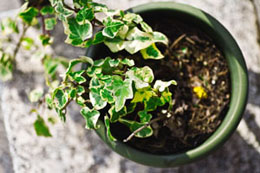Ivy, with its unusually shaped leaves that trail down beautifully, is a perfect plant to grow in hanging baskets, and even in tall cylindrical pots. This article will discuss some tips about ivy plant care.

Native to Europe, an ivy plant or climber adorns many homes, walls, fences, pathways, and trailers all across the world. Its bright green glossy leaves have made this plant a must-have if one is seeking to add an old-world charm to their home. Not to mention that a well-established and shaped ivy can also hide plenty of sore points in the landscape. The common ivy or the English ivy is botanically known as
Hedera helix, and belongs to the
Araliaceae family, the same family that the poison ivy belongs to. To ensure that this evergreen climbing plant thrives and flourishes, it must be cared for properly.
A single ivy plant can grow up to be around 65-100 feet tall, and has many twining delicate canes. The leaves borne are alternate and 2-4 inches long, depending upon the species. They can be either palmately five-lobed juvenile leaves, or unlobed cordate adult leaves (found mostly on fertile flowering stems). The greenish-yellow or whitish flowers, that are rich in nectar, are produced from late summer until late autumn, and the black to orange-yellow berries carrying about 2-3 seeds ripen in late winter. Given below is some information on how to take care of an ivy plant, which will be especially of use to you if you have been looking for information on indoor ivy plant care.
Propagation
An ivy house plant can be easily propagated by taking a stem or bare root cutting in spring or summer. Take a 10 inch stem from a year-old cane, clear all the lower leaves, and put it in a glass jar filled with plain water or mixed with rooting hormones. Stand the jar near a sunlit window sill. Change the water every alternate day. The roots will sprout within a week. One can even layer the cuttings, by pinning a part by gently bending the stem to the ground and creating a small incision in it. Sever the daughter plant from its parent after the roots sprout in a couple of weeks.
Ivy Plant Care
- Planting:
Ivy grows best in full, but not harsh, sun. If you plan to plant a hanging pot, just one plant per pot is more than enough. To use them as ground covers or climbers, plant as per the size of the intended location. Soil should be a mixture of de-weeded soil, peat moss or leaf mold, and gravel. Till the soil deep when planting in the ground. To induce a healthy growth, pinch off main leaf shoot. Allow lots of lateral branching. Fertilize well for a flush in growth.
- Pruning:
Pruning is essential for proper growth of the plant. Being a vigorous climber, ivy grows really fast, and runs out of shape quite often. Plus, it can easily get entangled and mess up the shape. Hanging ivy plants require light pruning in order to make them bushier and uniform. Ivy on wall, fence, or as ground cover needs to be pruned to keep the air and light well circulated. Provide a support system, like a trellis or nailed walls with nylon threads running through, as the ivy gets heavier and denser with age. To completely change the shape of the ivy, a hard prune after the last frost is recommended.
- Pest Control:
Small pests like spider mites, aphids, mealybugs, scales, and white flies are permanent residents of an ivy, especially the big climbers. The plant is also susceptible to bacterial leaf spot and stem canker, as the dense foliage traps moisture. Depending upon the size of the plant, adequate precautions need to be taken for pest control.
These tips on ivy plant care will prove to be effective for this fast growing plant that one uses as a ground cover to control erosion, cover vertical surfaces like walls or fences, or grow in a container indoors or outdoors. Wherever you grow them, you will definitely enjoy the happy green cascade!






 Native to Europe, an ivy plant or climber adorns many homes, walls, fences, pathways, and trailers all across the world. Its bright green glossy leaves have made this plant a must-have if one is seeking to add an old-world charm to their home. Not to mention that a well-established and shaped ivy can also hide plenty of sore points in the landscape. The common ivy or the English ivy is botanically known as Hedera helix, and belongs to the Araliaceae family, the same family that the poison ivy belongs to. To ensure that this evergreen climbing plant thrives and flourishes, it must be cared for properly.
Native to Europe, an ivy plant or climber adorns many homes, walls, fences, pathways, and trailers all across the world. Its bright green glossy leaves have made this plant a must-have if one is seeking to add an old-world charm to their home. Not to mention that a well-established and shaped ivy can also hide plenty of sore points in the landscape. The common ivy or the English ivy is botanically known as Hedera helix, and belongs to the Araliaceae family, the same family that the poison ivy belongs to. To ensure that this evergreen climbing plant thrives and flourishes, it must be cared for properly.